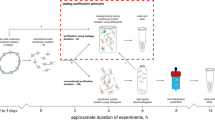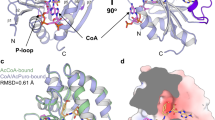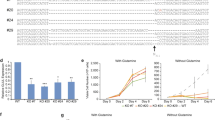Abstract
X-ray crystal structures of human membrane proteins, although potentially of extremely great impact, are highly underrepresented relative to those of prokaryotic membrane proteins. One key reason for this is that human membrane proteins can be difficult to express at a level, and at a quality, suitable for structural studies. This protocol describes the methods that we use to overexpress human membrane proteins from clonal human embryonic kidney 293 (HEK293S) cells lacking N-acetylglucosaminyltransferase I (GnTI−), and was recently used in our 2.1-Å X-ray crystal structure determination of human RhCG. Upon identification of highly expressing cell lines, suspension cell cultures are scaled up in a facile manner either using spinner flasks or cellbag bioreactors, resulting in a final purified yield of ∼0.5 mg of membrane protein per liter of medium. The protocol described here is reliable and cost effective, can be used to express proteins that would otherwise be toxic to mammalian cells and can be completed in 8–10 weeks.
This is a preview of subscription content, access via your institution
Access options
Subscribe to this journal
Receive 12 print issues and online access
$259.00 per year
only $21.58 per issue
Buy this article
- Purchase on Springer Link
- Instant access to full article PDF
Prices may be subject to local taxes which are calculated during checkout





Similar content being viewed by others
References
Engelman, D.M. et al. Membrane protein folding: beyond the two-stage model. FEBS Lett. 555, 122–125 (2003).
Popot, J.L. & Engelman, D.M. Membrane protein folding and oligomerization: the two-stage model. Biochemistry 29, 4031–4037 (1990).
Hessa, T. et al. Recognition of transmembrane helices by the endoplasmic reticulum translocon. Nature 433, 377–381 (2005).
Rapoport, T.A., Jungnickel, B. & Kutay, U. Protein transport across the eukaryotic endoplasmic reticulum and bacterial inner membranes. Annu. Rev. Biochem. 65, 271–303 (1996).
Wagner, S. et al. Consequences of membrane protein overexpression in Escherichia coli. Mol. Cell Proteomics 6, 1527–1550 (2007).
Wagner, S. et al. Tuning Escherichia coli for membrane protein overexpression. Proc. Natl. Acad. Sci. USA 105, 14371–14376 (2008).
Bowie, J.U. Solving the membrane protein folding problem. Nature 438, 581–589 (2005).
Klepsch, M.M., Persson, J.O. & de Gier, J.W. Consequences of the overexpression of a eukaryotic membrane protein, the human KDEL receptor, in Escherichia coli. J. Mol. Biol. 407, 532–542 (2011).
White, S.H. & Wimley, W.C. Membrane protein folding and stability: physical principles. Annu. Rev. Biophys. Biomol. Struct. 28, 319–365 (1999).
Dowhan, W. & Bogdanov, M. Lipid-dependent membrane protein topogenesis. Annu. Rev. Biochem. 78, 515–540 (2009).
Spector, A.A. & Yorek, M.A. Membrane lipid composition and cellular function. J. Lipid Res. 26, 1015–1035 (1985).
Guan, L., Smirnova, I.N., Verner, G., Nagamori, S. & Kaback, H.R. Manipulating phospholipids for crystallization of a membrane transport protein. Proc. Natl. Acad. Sci. USA 103, 1723–1726 (2006).
Long, S.B., Campbell, E.B. & Mackinnon, R. Crystal structure of a mammalian voltage-dependent Shaker family K+ channel. Science 309, 897–903 (2005).
Tate, C.G. Overexpression of mammalian integral membrane proteins for structural studies. FEBS Lett. 504, 94–98 (2001).
Helenius, A. & Aebi, M. Roles of N-linked glycans in the endoplasmic reticulum. Annu. Rev. Biochem. 73, 1019–1049 (2004).
Kwong, P.D. et al. Probability analysis of variational crystallization and its application to gp120, the exterior envelope glycoprotein of type 1 human immunodeficiency virus (HIV-1). J. Biol. Chem. 274, 4115–4123 (1999).
Aricescu, A.R., Lu, W. & Jones, E.Y. A time- and cost-efficient system for high-level protein production in mammalian cells. Acta Crystallogr. D Biol. Crystallogr. 62, 1243–1250 (2006).
Chang, V.T. et al. Glycoprotein structural genomics: solving the glycosylation problem. Structure 15, 267–273 (2007).
Lee, J.E., Fusco, M.L. & Ollmann Saphire, E. An efficient platform for screening expression and crystallization of glycoproteins produced in human cells. Nat. Protoc. 4, 592–604 (2009).
Reeves, P.J., Callewaert, N., Contreras, R. & Khorana, H.G. Structure and function in rhodopsin: high-level expression of rhodopsin with restricted and homogeneous N-glycosylation by a tetracycline-inducible N-acetylglucosaminyltransferase I-negative HEK293S stable mammalian cell line. Proc. Natl. Acad. Sci. USA 99, 13419–13424 (2002).
Gruswitz, F. et al. Function of human Rh based on structure of RhCG at 2.1 A. Proc. Natl. Acad. Sci. USA 107, 9638–9643 (2010).
Standfuss, J. et al. Crystal structure of a thermally stable rhodopsin mutant. J. Mol. Biol. 372, 1179–1188 (2007).
Chelikani, P., Reeves, P.J., Rajbhandary, U.L. & Khorana, H.G. The synthesis and high-level expression of a beta2-adrenergic receptor gene in a tetracycline-inducible stable mammalian cell line. Protein Sci. 15, 1433–1440 (2006).
Reeves, P.J., Thurmond, R.L. & Khorana, H.G. Structure and function in rhodopsin: high level expression of a synthetic bovine opsin gene and its mutants in stable mammalian cell lines. Proc. Natl. Acad. Sci. USA 93, 11487–11492 (1996).
Takayama, H., Chelikani, P., Reeves, P.J., Zhang, S. & Khorana, H.G. High-level expression, single-step immunoaffinity purification and characterization of human tetraspanin membrane protein CD81. PLoS ONE 3, e2314 (2008).
Rosenbaum, D.M. et al. GPCR engineering yields high-resolution structural insights into beta2-adrenergic receptor function. Science 318, 1266–1273 (2007).
Wurm, F. & Bernard, A. Large-scale transient expression in mammalian cells for recombinant protein production. Curr. Opin. Biotechnol. 10, 156–159 (1999).
Meissner, P. et al. Transient gene expression: recombinant protein production with suspension-adapted HEK293-EBNA cells. Biotechnol. Bioeng. 75, 197–203 (2001).
Bailey, C.G., Tait, A.S. & Sunstrom, N.A. High-throughput clonal selection of recombinant CHO cells using a dominant selectable and amplifiable metallothionein-GFP fusion protein. Biotechnol. Bioeng. 80, 670–676 (2002).
White, M.A., Clark, K.M., Grayhack, E.J. & Dumont, M.E. Characteristics affecting expression and solubilization of yeast membrane proteins. J. Mol. Biol. 365, 621–636 (2007).
Lewinson, O., Lee, A.T. & Rees, D.C. The funnel approach to the precrystallization production of membrane proteins. J. Mol. Biol. 377, 62–73 (2008).
Reeves, P.J., Kim, J.M. & Khorana, H.G. Structure and function in rhodopsin: a tetracycline-inducible system in stable mammalian cell lines for high-level expression of opsin mutants. Proc. Natl. Acad. Sci. USA 99, 13413–13418 (2002).
Schlaeger, E.J. The protein hydrolysate, Primatone RL, is a cost-effective multiple growth promoter of mammalian cell culture in serum-containing and serum-free media and displays anti-apoptosis properties. J. Immunol. Methods 194, 191–199 (1996).
Tharmalingam, T., Ghebeh, H., Wuerz, T. & Butler, M. Pluronic enhances the robustness and reduces the cell attachment of mammalian cells. Mol. Biotechnol. 39, 167–177 (2008).
Falk, T. et al. Over-expression of the potassium channel Kir2.3 using the dopamine-1 receptor promoter selectively inhibits striatal neurons. Neuroscience 155, 114–127 (2008).
Lohse, M.J. Stable overexpression of human beta 2-adrenergic receptors in mammalian cells. Naunyn. Schmiedebergs Arch. Pharmacol. 345, 444–451 (1992).
Gorman, C.M., Howard, B.H. & Reeves, R. Expression of recombinant plasmids in mammalian cells is enhanced by sodium butyrate. Nucleic Acids Res. 11, 7631–7648 (1983).
Kawate, T. & Gouaux, E. Fluorescence-detection size-exclusion chromatography for precrystallization screening of integral membrane proteins. Structure 14, 673–681 (2006).
Newby, Z.E. et al. A general protocol for the crystallization of membrane proteins for X-ray structural investigation. Nat. Protoc. 4, 619–637 (2009).
Acknowledgements
This work was supported by National Institutes of Health/National Institute of General Medical Sciences grants P50 GM73210, U54 GM094625 and R37 GM24485.
Author information
Authors and Affiliations
Contributions
S.C., F.G. and R.M.S. designed the experiments. S.C. and F.G. performed the experiments. S.C., J.E.P., F.G. and R.M.S. analyzed the data. V.S. and R.M.S. supervised personnel. S.C., J.E.P. and R.M.S. wrote the paper.
Corresponding author
Ethics declarations
Competing interests
The authors declare no competing financial interests.
Supplementary information
Supplementary Fig. 1
Full Sequence of pACMV-tetO. (DOC 27 kb)
Rights and permissions
About this article
Cite this article
Chaudhary, S., Pak, J., Gruswitz, F. et al. Overexpressing human membrane proteins in stably transfected and clonal human embryonic kidney 293S cells. Nat Protoc 7, 453–466 (2012). https://doi.org/10.1038/nprot.2011.453
Published:
Issue Date:
DOI: https://doi.org/10.1038/nprot.2011.453
This article is cited by
-
A nanobody-based strategy for rapid and scalable purification of human protein complexes
Nature Protocols (2024)
-
Ubiquitination regulates ER-phagy and remodelling of endoplasmic reticulum
Nature (2023)
-
Expression, Purification, and Crystallization of the Vγ9Vδ2 T-cell Receptor Recognizing Protein/Peptide Antigens
The Protein Journal (2023)
-
Identification of targets of AMPylating Fic enzymes by co-substrate-mediated covalent capture
Nature Chemistry (2020)
-
Thermostability of a recombinant G protein-coupled receptor expressed at high level in mammalian cell culture
Scientific Reports (2020)
Comments
By submitting a comment you agree to abide by our Terms and Community Guidelines. If you find something abusive or that does not comply with our terms or guidelines please flag it as inappropriate.



